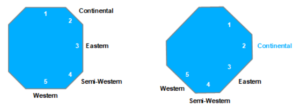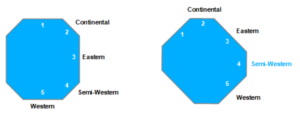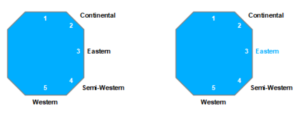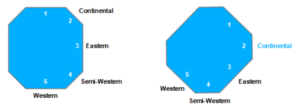Learn tennis lob
In 5 steps to the perfect tennis lob as a beginner
In 5 steps to the perfect tennis lob as a beginner
In tennis, the lob is an efficient shot, especially on the defensive, to get back into the rally or even win it directly. Most of the time the lob is the answer to a net attack of the opponent.
Tennis beginners usually learn the lob after they have built up initial confidence in the serve, forehand, backhand, volley and smash.
With the lob, one’s own game can be made even more flexible. The lob can be played on the forehand as well as on the backhand side with slice or topspin.
Below we explain to tennis beginners the 5 steps to the perfect tennis lob: from the grip, the backswing, the movement and the outswing to lob tips.
1. Tennis grip for lob
For a successful lob, the correct grip must be applied. The defensive lob is played as a slice and the aggressive lob as a topspin:
a) Lob on the forehand side
On the forehand side, the defensive slice lob is played in the Continental grip. The tennis racket is slightly bent forward in the lateral position at the bottom.
The aggressive forehand topspin lob is played in the Semi-Western grip. The tennis racket is slightly bent forward in the lateral position at the top.


b) Lob on the backhand side
On the backhand side, the defensive slice lob is played in the Eastern grip. The tennis racket is slightly bent forward in the lateral position at the bottom.
The aggressive backhand topspin lob is played one-handed and two-handed mostly in the Continental grip. The tennis racket is slightly bent forward in the lateral position at the top.


2. Tennis outswing
You are in the center of the court and realize that your opponent is playing an attacking shot and is advancing to the net. You are in the classic starting position: tennis racket centered in front of you with both hands clasped and feet open.
As soon as your opponent hits the tennis ball, you decide whether to play forehand or backhand. Depending on the quality of the opponent’s attacking shot, you decide on a defensive or aggressive lob as an alternative to a passing ball.
The defensive slice lob is a good choice if the opponent’s ball is played so well that it is important for you to get back into the rally.
The aggressive topspin lob, on the other hand, makes more sense when your opponent advances far to the net and the court is open behind him. The topspin jumps away with a forward spin, so that the opponent has no realistic chance to return the ball, even by running back.
The difference to the normal forehand or backhand topspin backspin is that the tennis racket is dropped even lower during the circular backspin.
3. Tennis movement
The clean movement of the topspin lob allows the tennis racket to swing upwards in a circle at the point of impact with spin over the tennis ball. The important thing here is the simultaneous shift to the back foot, so that the slight backward position without loss of balance helps you to play the ball high.
The motion of the slice lob is mostly in full extension to reach the tennis ball at all. You hit the ball with an “undercut” – to create the backspin – so that the ball rises accordingly much more vertically.
Ideally, you hit the ball again in front of the body during the lob, but the lob can also still work at body height.
4. Tennis outswing
The topspin lob is swung out over the shoulder in the same way as the normal forehand and backhand. With the slice lob, you pull the tennis racket further up after the point of impact.
Then, as always, return to the center of the court and prepare for the next stroke.
Note that both the backswing, the movement and the outswing are fluid movements.
5. Typical lob mistakes and tips
a) Do not play the topspin lob too passively.
Many tennis beginners let themselves fall backwards too early when playing the topspin lob. As a result, the ball does not reach the appropriate length and can be played directly as a smash by the opponent waiting at the net. Therefore, do not become too passive and play an aggressive topspin lob in front of the body.
b) Observe the position of the opponent
Don’t play the lob just because you know the stroke. Pay attention to your opponent’s position just before you hit the ball: the closer your opponent is to the net, the more difficult it is to pass the ball and the better it is to lob. If your opponent is on his way to the front of the net just before you hit the ball, a lob makes less sense.
c) Advance to the net after a promising topspin lob
A well-placed topspin lob makes the opponent run back. Since hitting while running backwards is especially difficult, this is your opportunity to go on the attack yourself and advance to the net. If the opponent still gets the ball and plays it back, it will usually go over the net. By advancing, you put yourself in the ideal position to win the point, e.g. with your own smash.

